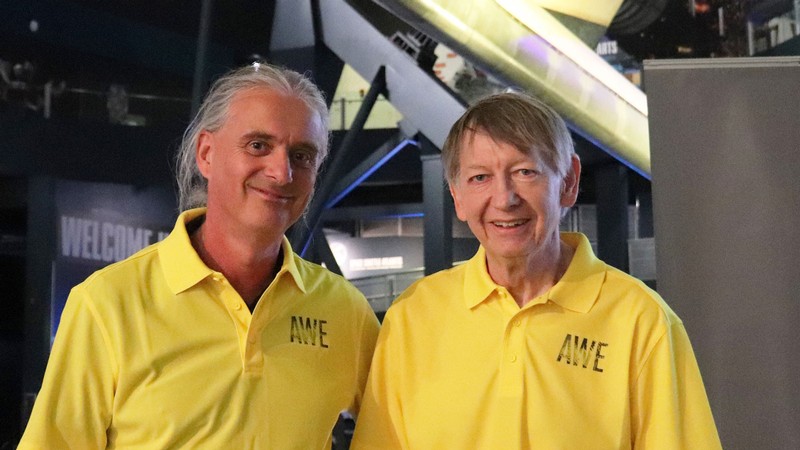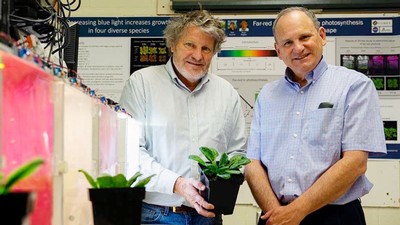A Dream Realized: USU Physicist Pioneers New Era of Atmospheric Waves Research
Mike Taylor passes the torch of groundbreaking NASA-funded AWE science mission to fellow USU professor Ludger Scherliess.
By Mary-Ann Muffoletto |
USU Physics Professor Mike Taylor, right, who conceived USU's NASA-funded Atmospheric Waves Experiment (AWE), passes the leadership torch to fellow professor Ludger Scherliess, left. Taylor, who has studied atmospheric waves for nearly four decades, is retiring as the mission’s principal investigator. (Photo: USU/M. Muffoletto)
Wrapping up his bachelor’s studies at the University of Southhampton in his native England in 1976, Mike Taylor should have been walking on air. After all, the physics major had an enviably steady engineering job lined up in the telecommunications industry. Instead, the undergrad felt dejected.
“I was feeling rather low,” recalls Taylor, physics professor at Utah State University. “I had a job, but I wanted something exciting.”
Leaving the university’s physics department on a Friday afternoon for what he thought would be the last time, Taylor noticed a non-descript flier on a bulletin board seeking students for space research.
“I lit up on that, ran upstairs, knocked on the door of a lecturer I’d never met before,” he says. “We talked for more than an hour and she basically hired me on the spot.”
That serendipitous meeting led to a yearslong collaboration with the European Space Agency, along with the start of a lifelong career in space physics. Taylor specifically pioneered innovative use of varied camera technologies to observe how lower atmospheric dynamics drive upper atmospheric variability, captured in more than 200 peer-reviewed papers and cited nearly 10,000 times.
On Nov. 9, celebrating more than 40 years of discovery, Taylor, as principal investigator of the NASA-funded AWE (Atmospheric Waves Experiment) mission, watched the culmination of his efforts in a breathtaking launch of the AWE instrument from Florida’s Kennedy Space Center to the International Space Station, that heralded a new chapter of global atmospheric observation from space.
Embarking on well-earned retirement, Taylor is now passing the torch to a new principal investigator.
“We are grateful for Mike’s lifetime of extraordinary contributions to atmospheric science,” says USU Science Dean Michelle Baker. “Not to go unnoticed are his equally impactful efforts as a teacher and mentor to both undergraduates and graduate students, and as a kind and supportive colleague to faculty and staff.”
Effective Nov. 13, NASA named USU physics professor Ludger Scherliess as Taylor’s successor.
“I am excited and humbled by this new appointment,” says Scherliess, who joined USU’s Department of Physics in 1998. “This is a unique opportunity to advance our understanding of atmospheric waves.”
As the new principal investigator of AWE, Scherliess, who earned a doctoral degree from Utah State in 1997, joins a highly talented and diverse team of space scientists and engineers whose academic and career paths have intertwined for decades.
Both Scherliess and Taylor were recruited to Utah State to join the university’s pioneering efforts in space and atmospheric research, initiated in the 1950s and rooted in longstanding partnerships with NASA and the National Center for Atmospheric Research in Boulder, Colorado.
Scherliess worked at NCAR immediately following completion of his doctoral degree, before being invited to join USU’s Department of Physics.
Current and former members of the AWE Team include University of Colorado professor Jeff Forbes and NCAR researcher Hanli Liu, along with retired NCAR scientist Maura Hagan, who served as USU science dean.
The mission is a joint effort of USU and the university’s renowned Space Dynamics Laboratory, which built the AWE instrument now attached to the outside of the ISS to globally map atmospheric waves and transmit the images back to Utah State.
Rounding out the group are USU Physics Research Professors Yucheng Zhao and Pierre-Dominique Pautet, longtime colleagues of Taylor and Scherliess, along with former USU postdoctoral fellow Jonathan Snively, a faculty member at Florida’s Embry-Riddle Aeronautical University.
Members of this team, led by Taylor and accompanied by students, have traveled the corners of the earth chasing atmospheric waves, including journeys to remote areas of Alaska and Chile, as well as the South Pole.
“Through years of effort, travel and determination, we mapped images of waves from varied locations the Earth,” Taylor says. “Now, with AWE, the excitement is just beginning. From the ISS, our mapping camera will capture images from space on a global scale. This takes our research to a whole new level and affords new generations of scholars with study opportunities we never thought possible.”
AWE is a Mission of Opportunity under NASA’s Heliophysics Explorers Program, which conducts innovative, streamlined scientific investigations by developing instrumentation to answer focused science questions that augment and complement the agency’s larger missions. AWE joins a fleet of heliophysics missions positioned at key places around the solar system, which together seek to understand the way the constant outflow of energy and particles from our Sun affects interplanetary space — information that not only teaches more about our astrophysical neighborhood, but helps protect astronauts and technology in space.
This material is based upon work supported by the National Aeronautics and Space Administration under Contract Number 80GSFC18C0007. Any opinions, findings, and conclusions or recommendations expressed in this material are those of the author(s) and do not necessarily reflect the views of NASA.
WRITER
Mary-Ann Muffoletto
Public Relations Specialist
College of Science
435-797-3517
maryann.muffoletto@usu.edu
TOPICS
Research 881stories Space 140stories Physics 99stories SDL 89stories NASA 83stories Satellites 67storiesComments and questions regarding this article may be directed to the contact person listed on this page.







